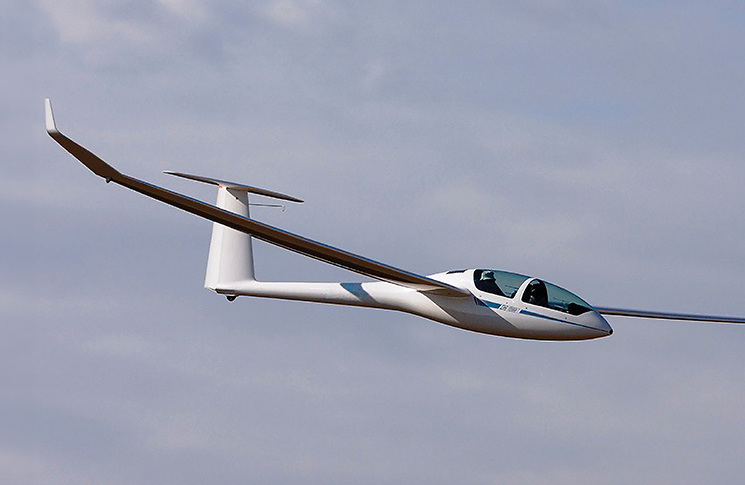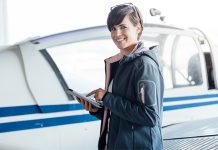A birthday gift allowed pilot Michael Apps to compare and contrast modern gliding with his early experiences of the sport.
Germany was banned from developing an air force after the end of World War 1 so developed gliding as a sport to ensure a supply of pilots for future conflicts. This move ensured it was able to rebuild the Luftwaffe rapidly in the 1930s.
The British military also recognised the value of gliding and instituted the Air Training Corps to ensure its future needs, a move that became for many – including me – the doorway to powered flying.
My story started just at the end of World War II when I joined 304 Squadron Air Training Corps. Each weekend we would travel to RAF Kenley, a Battle of Britain airfield, and commence very basic training on an Elliotts Primary EoN glider – attached by a 50-foot (15 metre) length of rope to the back of an armoured car.
The first lessons comprised sitting on the glider and being towed across the airfield, with a corporal positioned in the back of the car shouting at the student trainee pilot to ‘keep straight and hold the wings level!’. After many weeks and untold dramas, the few remaining students progressed, the car was sped up and the glider became airborne. At 8 to 10 feet, the student pulled the release for what was called a ‘low hop’. Then came high hops of 30 to 50 feet, refining small turns and improving the landings until eventually, 2 of us graduated to flying a very short and exciting circuit.
Looking back at those early days and the level of instruction and lack of expertise, I am amazed so little damage was done to the primitive gliders but, perhaps more surprisingly, no injuries were sustained by some enthusiastic but not very capable students.
I joined the Royal Navy in 1949 and flew with the Fleet Air Arm during the next 24 years until 1973 when I left to resume a civilian career. During my time in the military and when ashore at various Royal Naval Air Stations, I was able to continue gliding and instructing students, having achieved an instructor rating during my basic flying training in 1950. All the training was carried out using winch launches or being towed behind cars or trucks and reaching altitudes of 1,000 to 2,000 feet, depending on wind strengths and runway lengths.
The gliders used for training in those days comprised mainly side-by-side two-seaters like the then common and very popular Slingsby T.21 Sedbergh open cockpit built in 1944, or the Slingsby T.49 Capstan and the even more popular LET L-13 Blanik produced in 1956. The Blanik became the most numerous and widely used glider in the world.
In the single-seat class was the EoN Olympia wooden and fabric glider, a really lovely aircraft to soar the skies. Others included the Pilatus B-4, an all-metal intermediate glider built by Pilatus Aircraft of Switzerland in 1966, and the Glasflugel H-201 Libelle which was an early composite standard class single-seat glider produced in 1967. Finally, we also had the SZD-30 Pirat single-seat multipurpose glider from the Polish firm PZL Bielski which first flew in 1966.
After resigning from the Royal Navy in 1973, I lived close to the Naval Air Station at Yeovilton in Somerset and continued to teach gliding and tow gliders using the Navy’s DHC-1 Chipmunk aircraft. Aero tows were a far more satisfactory and reliable method of getting gliders airborne to basically any height they wanted to go – gliders could be towed to any area of obvious lift.
At this time I decided to buy a competition glider – a Skylark 4 British single-seat glider built by Slingsby Sailplanes in the 1960s. I flew the aircraft for pleasure though without luck in various competitions and sold it in 1977 just before coming to Australia.
The Royal Australian Navy offered me a job in Canberra in 1977. I was able to continue gliding and aircraft towing at Nowra Naval Air Station and the Canberra Gliding Club site at Cooma, in southern NSW. Compared to the UK, conditions were much better in Australia, so I spent much of my early time in Australia doing a lot more gliding. For the next 10 years, I flew cross-country flights in the ever popular two-seat Blanik, honing my skills at wave soaring and entering gliding competitions.
During this time in the mid to late 1980s, I was able (with a co-pilot) to win 4 two-seat NSW State competitions; however, the highlight was in the final race when we beat all the other aircraft – including the faster single-seat aircraft – to the finish line at Temora.
I was also able to expand my repertoire as an instructor, taking on instructor training and examining and training tug pilots. I had acquired over 4,000 hours in gliders and, towards the end of the 1990s, spent more time towing gliders in competitions and in the club scene. As regional training officer (operations) for NSW for 6 years, I spent much of my spare time visiting the many gliding clubs in the state and making enduring friendships.
My wife and I bought Polo Flat Airfield near Cooma in 1998 and I had to give up my gliding hobby so I could concentrate on fixed-wing flying and developing a flying school, training people from students with disabilities to instructors, military students and pilots from overseas. We sold the airfield in 2019 and, after 73 years of flying and gliding, I considered my flying days were over.
So you can imagine my delight when, for my 91st birthday this year, my friend Alan Wilson from the Canberra Gliding Club invited me to the Bunyan Airfield near Cooma for a flight in their new two-seat DG 1001S glider. I jumped at the offer and spent 75 minutes having the time of my life in a machine that was 21st century – and then some.






Comments are closed.